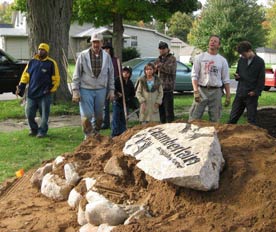In the November 1999 issue of Shelterforce, Ralph Nader wrote:
A study released by the Federal Deposit Insurance Corp. (FDIC) last month found that consolidation in the banking industry just between the years of 1990 and 1997 had “increased the risk of insurance fund insolvency by 50 percent.” The report warned that the risk had increased further during the past two years.
The risk of insolvency is “becoming inseparable from the health of the 25 largest banking organizations which control 54.5 percent of the assets,” the FDIC researchers found. These are the very institutions that will be combined with insurance companies and securities firms in the new, too-big-to-be-allowed-to-fail conglomerates.
I guess radicals at the FDIC knew what might be in store for us after the Gramm-Leach-Bliley Act of 1999 repealed the Depression-era Glass-Steagall Act, which kept banks from merging with finance, insurance, and securities firms.
Gramm-Leach-Bliley was not the sole cause of our economic meltdown, but it did contribute to the inevitable onset of the Great Recession. To undo some of the bill’s worst mistakes and provide a measure of safety for individuals and communities, both the House and Senate have passed financial reform bills. The bills are now in conference and representatives from both houses will be hammering out a compromise.
A few months ago, as the individual bills were being drafted, we had the opportunity to meet with Congressman Barney Frank, the chairman of the House Financial Services Committee. Frank discusses these bills as well as the future of FHA, Fannie, and Freddie, and affordable rental housing, among other things. He says that a real solution to the housing crisis will only come when organizations “join together and advocate for the resources” needed. He encourages advocates to “promote cutting the military budget and raising taxes on rich people,” as the only real solution — a solution that requires mobilization, he says.
But where will that mobilization come from? In this issue we feature a group of articles that look at the challenges to effective organizing and profile two successful organizing groups.
Also in this issue, Randy Stoecker examines the drift from confrontational to relational organizing. Stoecker sees the latter form as more development than organizing. While the two work hand-in-hand, they are not the same: “Community organizing fights to change power relationships while community development focuses on operationalizing the benefits that come from changed power relationships. Community organizing fights the rules that direct resources away from poor communities. Community development puts to work the new resources that community organizing wins.” Stoecker cautions that without power organizing the rules of the game will never change.
But not all development organizations can’t or won’t use power-organizing methods. James DeFilippis, Robert Fisher, and Eric Shragge describe three groups that have managed to do both. The authors share Stoecker’s concern about the drift from power to consensus organizing and provide further analysis of the relational approaches. Among the organizations they profile is ACORN.
Few organizations have been so successful at fighting for the rights of the poor and so vilified, for that very success, by the repressive forces in this country. ACORN’s vilification went far beyond the typical lies and vitriol spewed by the right. While ACORN’s enemies attacked, many of ACORN’s friends hid and the media seemed to, at best, forgo their role as seekers of truth. How the media dropped the ball, the allies ran, and ACORN fought back is documented in John Atlas’s article.
Atlas is one of the founders of Shelterforce and a life-long advocate for social justice. We’re proud to announce the publication of his new book on ACORN, Seeds of Change: The Story of ACORN, America’s Most Controversial Antipoverty Community Organizing Group. His book is a fascinating view of ACORN’s accomplishments and blemishes, but more than that, it shows us how important organizing — grassroots and, when necessary, confrontational — is for democracy.
Later in this issue, Michael McQuarrie writes about the winning strategies used by Cleveland-based Empowering and Strengthening Ohio’s People in their battle against foreclosure. And in London, Dave Smith describes the battle to win the right to create up to 100 community land trust homes in the footprint of the 2012 Olympics and a commitment to the creation of 2,000 more after the games conclude.
The need for and potential of organizing is echoed throughout this issue of Shelterforce. If we want the rules of the game to change, these articles remind us, we’ll have to do a lot more than build another house and hope for the best.





Comments